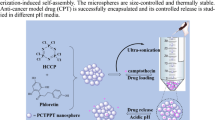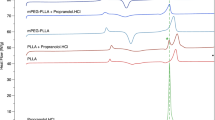Summary
Poly (propylene-ram-ε-caprolactone carbonate) (PPCL) and poly (propylene carbonate) (PPC) were synthesized by ring-opening copolymerization from carbon dioxide, propylene oxide (PO) and ε-caprolactone (CL) using a polymer-supported bimetallic complexes (PBM) as catalyst. PPC and PPCL microspheres containing a 5-alpha reductase inhibitor, finasteride were elaborated by a conventional oil-in-water (O/W) emulsion-solvent evaporation method. The effects of polymer used on microspheres morphology, size, drug loading, encapsulation efficiency and drug release behaviors were examined. In vitro drug release of these microcapsules was performed in a pH 7.4 phosphate-buffered solution. A prolonged in vitro drug release profile was observed. The release profiles of finasteride from PPC and PPCL microcapsules were found to occur with a burst release followed by a gradual release phase. Drug release rates were dependent upon the properties of the polymer in the microspheres, the higher hydrolytic activity of polymer provided faster release rate.
Similar content being viewed by others
References
Freiberg S, Zhu XX (2004) Int J Pharm 282: 1
Uhrich KE, Cannizzaro SM, Langer RS, Shakesheff KM (1999) Chem Rev 99: 3181
Rokicki G (2000) Prog Polym Sci 25: 259
Zhu KJ, Hendren RW, Jensen K, Pitt CG (1991) Macromolecules 24: 1736
Edlund U, Albertsson AC (2001) Adv Polym Sci 157: 67
Lu LB, Huang KL (2005) Polym Int 54: 870
Liu SQ, Xiao H, Huang KL, Lu LB, Huang QY (2006) Polym Bull 56: 5
Liu YF, Huang KL, Peng DM, Wu H (2006) Polymer 47: 8453
Sinha VR, Bansal K, Kaushik R, Kumria R, Trehan A (2004) Int J Pharm 278: 1
Goodwin CJ, Braden M, Downes S, Marshall NJ (1998) J Biomed Mater Res 40: 204
Causa F, Netti PA, Ambrosio L, Ciapetti G, Baldini N, Pagani S, Martini D, Giunti A (2006) J Biomed Mater Res 76A(1): 151
Ferruti P, Mancin I, Ranucci E, Felice CD, Latini G, Laus M (2003) Biomacromolecules 4: 181
Zhou SB, Deng XM, Yang H (2003) Biomaterials 24: 3563
Yen MS, Kuo SC (1998) J Appl Polym Sci 67: 1301
Roehrborn CG (2003) Rev Urol 5 Suppl 5: S12
Heinzl S (1999) Med Monatsschr Pharm 22(4): 124
Coltman CA, Thompson IM, Feigl P (1999) Eur Urol 35(5-6): 544
Tkachuk VN, Al’-Shukri SKh, Kornienko VI, Kuz’min IV (1998) Urol Nefrol (Mosk) 4: 37
Sudduth SL, Koronkowski MJ (1993) Pharmacotherapy 13(4): 309
Guyot M, Fawaz F (1998) Int J Pharm 175: 61
Author information
Authors and Affiliations
Corresponding author
Rights and permissions
About this article
Cite this article
Peng, D., Huang, K., Liu, Y. et al. Preparation of carbon dioxide/propylene oxide/ε-caprolactone copolymers and their drug release behaviors. Polym. Bull. 59, 117–125 (2007). https://doi.org/10.1007/s00289-007-0747-z
Received:
Revised:
Accepted:
Published:
Issue Date:
DOI: https://doi.org/10.1007/s00289-007-0747-z




